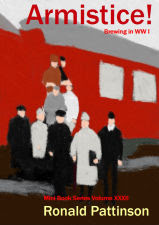By the time you read this, it should be available to purchase. All 600-odd pages of it. Now why did I class this as a mini-book? I suppose I didn't expect the recipes to get so out of hand. My guess was 250. It ended up over 370. Even more than Scotland! volume II.
Anyway, here' the recipe:
One of the weirder appearances in the Barclay Perkins records are what appear to be brews for Watney.
It has the same name as one of their own beers – XLK. But that name wasn’t unique to Barclay Perkins. Truman also had a beer with the same name. The cheap and cheerful Bitter that, unlike their other Pale Ales, was brewed in London rather than Burton.
As it’s different in grist and gravity from either of Barclay Perkins own XLKs, I can only assume that this was being brewed for Watney. Maybe Barclay Perkins had spare capacity. As breweries had were pegged as a percentage of their 1914 output, I’m not sure why they would waste some of that brewing for someone else.
The recipe is quite similar to Barclay’s own XLK. That’s not a surprise, seeing as they were both brewed for the same London market. Its gravity falls about exactly between those of Barclay’s draught and bottled versions.
The hopping is a bit different from Barclay’s, though the hops are all still English: Kent (1914 CS, 1915 CS, 1916 and; Worcester (1915 CS) dry hops.
| 1916 Barclay Perkins XLK (Watney) | ||
| pale malt | 6.75 lb | 69.80% |
| flaked maize | 1.25 lb | 12.93% |
| No. 2 invert sugar | 0.67 lb | 6.93% |
| glucose | 1.00 lb | 10.34% |
| Fuggles 120 mins | 1.00 oz | |
| Fuggles 90 mins | 0.75 oz | |
| Goldings 30 mins | 0.75 oz | |
| Goldings dry hops | 0.25 oz | |
| OG | 1047 | |
| FG | 1012 | |
| ABV | 4.63 | |
| Apparent attenuation | 74.47% | |
| IBU | 32 | |
| SRM | 5 | |
| Mash at | 152º F | |
| Sparge at | 170º F | |
| Boil time | 120 minutes | |
| pitching temp | 59.5º F | |
| Yeast | Wyeast 1099 Whitbread Ale | |
This recipe - and many others - are in my latest book.
A history of British brewing during WW I, with lots and lots of numbers and ludicrous number of recipes is available for purchae, But a copy. Buy several and give the spare ones to your friends.
A history of British brewing during WW I, with lots and lots of numbers and ludicrous number of recipes is available for purchae, But a copy. Buy several and give the spare ones to your friends.


Re:quotas - is there any evidence that it was intended for the war effort in some way, or quota moved from Watney to BP because Watney employees were conscripted?
ReplyDeleteqq,
ReplyDeleteno idea. In general, brewers were allowed to brew a percentage of the beer they had in the last pre-war year. I can't see why a brewery would want to use some of their allowance to brew for someone else. There must be a good reason that I'm unaware of.
In WW II you see this more often, a brewery brewing another brewery's beers. But it was all to do with rationalising supply and saving fuel. A brewery with a few tied houses quite a way from the brewery would have their beer for those pubs brewed by a brewery that was closer.
That can't apply in this case as both breweries were located in London.
We don't know they were "using some of their allowance to brew for someone else". If Watney were contributing quota, either directly or indirectly through a swap agreement, then you would have savings through sharing a full gyle when each brewery only had quota for half a gyle, or if one brewery didn't have the manpower to brew full-time, or the brewery had been hit by a Zeppelin or something.
ReplyDeleteBut knowing how government twists its rules to its own ends, I can't help feeling it's something to do with brewing for the war effort somehow.